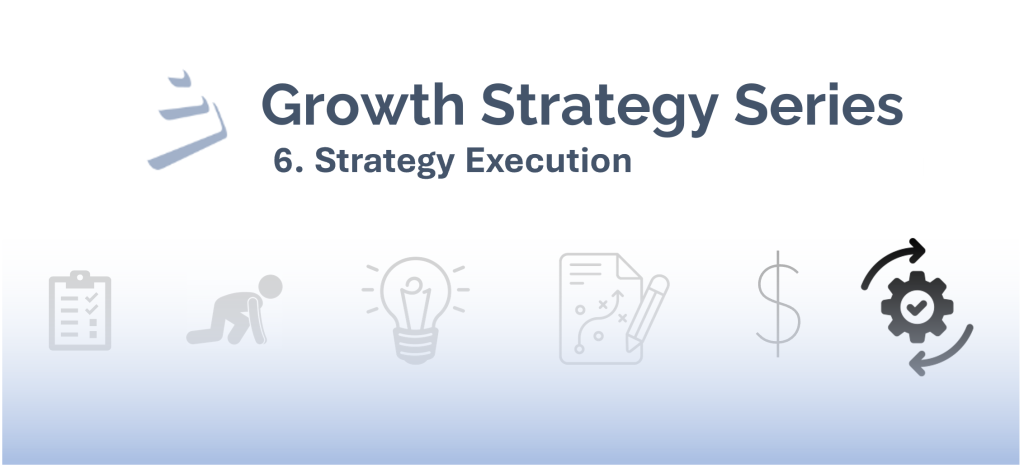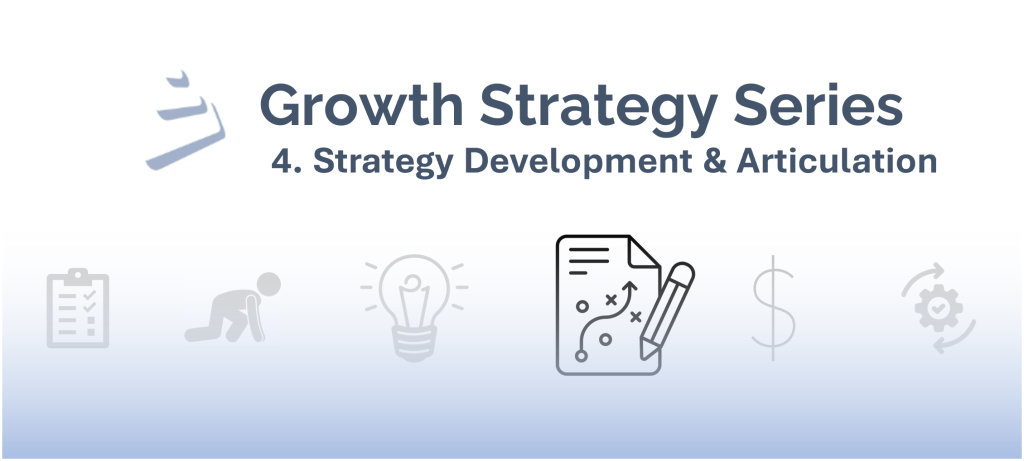Chapter 5 Recap
Welcome to the final chapter of the growth strategy series. In our last chapter, we discussed strategy quantification, including team composition, roles and responsibilities, and best practices when identifying and quantifying the underlying strategic initiatives supporting each imperative. Key takeaways are as follows:
- Be sure to dedicate enough time to brainstorming, evaluating, and vetting the supporting initiatives underlying each imperative
- Cast a wide net and prioritize early – don’t burn energy building a detailed quantification of a laundry list of potential initiatives
- Divide the effort by assigning initiative leads to quantify each initiative, but be clear on the level of detail required; differing levels of detail create challenges aggregating and building a consolidated output
- Develop an aggregated long-term view with revenue and earnings bridges and annual capital spend plans. Gain board alignment with a specific set of KPIs identified for measurement
This chapter covers strategy execution: how to deliver the value promised by the strategy.
Chapter 6: Strategy Execution
Execution as the Culmination of Strategy Development
A well-developed, articulated and quantified strategy is achievable, actionable, backed by data and market understanding, and specifically tailored to your business and its strengths. However, it means nothing without execution to ultimately translate the intended strategic outcomes to value for your organization. A Harvard Business Review study estimates that 67% of well-formulated strategies fail due to poor execution.[1]
Whether making small tweaks to the existing strategy or wholesale changes, execution requires effort, accountability and change across the organization to ensure success and sustainability. In Denneen & Company’s view, there are 5 key requirements to successful strategy execution:
- Communicate the strategy
- Align your org structure and right-size capacity
- Define ownership, accountability, and incentives
- Measure progress
- Assess and course-correct
Communicate the Strategy
According to the same Harvard Business Review study, on average, 95% of a company’s employees are either unaware of, or do not understand, its strategy.[2] Without awareness or understanding, it is impossible for employees to adopt and evangelize the strategy. In simple terms, organizational buy-in is achieved through clear and consistent communication. In addition to developing an easy-to-remember vision and purpose, try to develop a catchy, easy-to-remember slogan that characterizes your strategy in simple terms and functions as a call-to-action.
Effectively communicating the strategy improves decision-making and prioritization at all levels of the organization as employees better understand what day-to-day tasks, projects and activities best support the company’s strategic objectives. In summary, developing a sense of knowledge and empowerment at all levels focuses and motivates the organization, increasing the effectiveness of the strategy.
Align your Org Structure and Right Size Capacity
Strategy development leads to difficult choices that change the trajectory of the company, and these choices can bring about a myriad of changes: new, repurposed, or repackaged products, an emphasis on new channels or customer groups, or an entirely different value proposition for your product or service. Major shifts in segmentation, targeting, or positioning require a closer look at organizational structure (lines of business, functional structure, etc.) to ensure that resources are well aligned to achieve your strategic objectives. Job descriptions may also need to be refreshed, or new roles created to align with the new strategic direction. Inability to adapt organizational structure to a strategy is a key pitfall in execution – Gartner estimates that 67% of key functions are not aligned with business unit and/or corporate strategies.[3]
In addition to better aligning your organizational structure to your growth pillars and initiatives, ensure that internal controls, processes and capabilities are scalable and prepared to grow with your enterprise. For example, if new customer and product groups are being introduced as part of a strategy, IT infrastructure should be evaluated and updated to accurately process and analyze new data and information related to these customer and product groups.
Revenue or volume growth objectives identified in the strategy cannot be captured if capacity does not exist to deliver it, so you must right-size capacity to ensure your organization can capture growth opportunities. Depending on industry, capacity could refer to manufacturing capacity (products), human capital (professional services), processing/storage capacity (software and technology services), or even physical space. Think creatively about capacity expansion early in your growth journey. Identify levers to pull internally to maximize existing capacity and consider leveraging co-manufacturers or flexible 3rd party arrangements as a capacity valve before committing significant capital to capacity expansion. That said, if demand is proven and the business case is viable, a significant investment in capacity expansion may be the optimal path forward.
Define Ownership, Accountability, and Incentives
As mentioned in our previous chapter, the strategic initiatives identified during strategy development must be continuously expanded upon and tracked via a charter. Charters break down each initiative into individual activities, assign time frames and quantifiable outcomes, define risks and mitigation strategies, and most importantly define a sponsor. That sponsor is ultimately charged with executing that initiative and is held accountable for its outcome.
Beyond defining a sponsor, leverage the initiative charter to organize a team around each initiative. The individuals on each team are tasked with ensuring the various functions and groups are well aligned towards achieving the initiative. Similar to a strategy development core team, think carefully about the individuals and functions included when building your initiative team. For example, a goal to grow relationships at certain key accounts for a consumer products company may look like a sales and marketing initiative on the surface. However, there are operational impacts on product mix, production volumes and outbound logistics when increasing sales to key customers, particularly customers that may have a broad geographic footprint with multiple distribution points.

Sample initiative charter template – format and setup of initiative charters can be adjusted based on preference

Illustrative charter for a brand looking to expand into Mexico
From an incentive standpoint, involvement in strategic initiatives should factor into employee performance evaluations and be sought after by employees seeking promotion opportunities. As the ultimately accountable parties, you should also reward initiative leads and imperative sponsors for successful completion.
To keep execution on track, a standard review cadence for initiatives, imperatives and the overall strategy is critical to track progress towards objectives and outcomes.
Measure Progress
As mentioned in our last chapter, key strategic KPIs should be developed as part of strategy quantification, with input and alignment from the board. The key to establishing proper KPIs is quality over quantity – aligning on fit-for-purpose, choiceful KPIs that track progress towards outcomes rather than capturing activity. Depending on the group and their responsibilities, different progress review cadences should be developed.
Weekly or monthly initiative reviews: Initiative teams should meet at least once a month to discuss recent activity, upcoming next steps and road blocks. In addition to reviewing progress towards the core KPIs aligned upon with the board, initiative teams can also define their own specific, more granular metrics and KPIs to track progress – for example, an operational initiative may track asset utilization, production levels, or service metrics like OTIF.
Quarterly imperative reviews: On a quarterly basis, the imperative team should measure progress related to executing the strategy. Initiative leads should raise any red flags to the imperative sponsors, and imperative sponsors should provide guidance and support in navigating roadblocks. Key KPIs should be tracked and measured during this meeting, with adjustments to the plan made to improve KPIs.
Annual Strategy reviews: On an annual basis, imperative sponsors and the steering committee should convene to review KPIs and discuss progress in strategy execution, ensure the long-term outlook remains strong, and assess and course correct.
Assess and Course Correct
Finally, we finish where we started, strategy assessment. Don’t let your strategy collect dust on a shelf; treat it as a living document. As part of the annual strategy review, we recommend re-applying the strategy assessment framework to ensure the purpose and vision still resonate and your strategic choices and imperatives are still valid. When necessary, adjust your strategy and course correct. Regular strategy assessments increase confidence in the company’s overall trajectory, and hopefully minimize the need for massive, expensive strategic overhauls that send operational and cultural shockwaves throughout the business.
Takeaways:
Execution translates the strategy development exercise into value for your enterprise. When executing your strategy, keep the following in mind.
- Gain organizational buy-in through clear communication and a call-to-action
- Make sure your organization is structured to capitalize on strategic priorities, and have a plan to match capacity to revenue growth
- Leverage initiative charters to organize teams around strategic initiatives, define ownership and accountability, create incentives, and track progress
- Treat your strategy as a living document; conduct annual strategy assessments, incorporate new developments and information, and course correct as needed
Thank you for reading along with the Growth Strategy Series. At Denneen & Company, we are passionate about helping our clients develop pragmatic, actionable and achievable growth strategies. We hope this series provides a helpful glimpse into our process and acts as a guide as you think about your own growth strategy.
For questions about the strategy development series, or how we can help at any stage of a strategy development, contact Mike Gill, Senior Consultant, or Pieter Rhynhart, Consultant, at Denneen & Company.
Denneen & Company is a growth strategy consulting firm that has been helping companies find and follow their unique paths to growth for over 30 years. With experience across 20+ industries, 40+ consumer categories, and 40+ countries, Denneen & Company consultants leverage their former backgrounds as industry practitioners and past engagements to develop practical and achievable strategies based on rigorous analysis, breakthrough insights, and a collaborative approach. To learn more, please visit denneen.com.
[1] The Office of Strategy Management (hbr.org)



